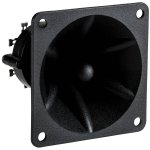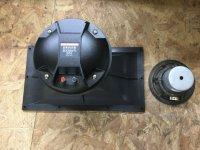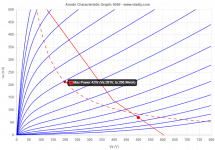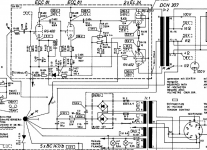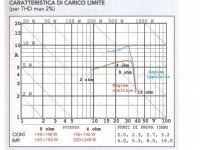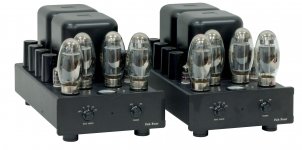I have a pair of Klipsch RF82 ( https://2d73e25b29782b6d6766-9c8af5...cf2.rackcdn.com/RF82II_635042119237310000.pdf )and will have a pair of fullrange speakers early 2022.
Is that common to blow tweeters?
Is that common to blow tweeters?
You’d have to turn those up a lot louder than mine before blowing those - a compression driver will have some 6dB or more pad in the crossover to match the woofers. That reduces the actual power going in. But as a general rule when clipping gets dangerous for speakers or amps it sounds pretty bad. When it sounds bad you turn it down, saving the speakers and amp. My larger main speakers have ribbon tweeters. I blow them occasionally - usually it happens by accident when a commercial comes on full blast due to a remote control issue. They *are* cheap and easy to fix, which is why the TLRs didn’t end up in that system.
PA and instrument use is different, because some level of gross distortion is generally acceptable. You need to analyze those applications on a case by case basis.
PA and instrument use is different, because some level of gross distortion is generally acceptable. You need to analyze those applications on a case by case basis.
I’m gonna go out on a limb here and say that if you’re using those you’re probably not running nicer tubes in ultralinear.
If you really want blowout proof tweeters try these. Perhaps a good match with a 2A3 SET, as well (6.5 inch woofer for comparison).
If you really want blowout proof tweeters try these. Perhaps a good match with a 2A3 SET, as well (6.5 inch woofer for comparison).
Attachments
I remember even Marshall switched to 5881 during 90s because there were no reliable EL34.
What you mean by "even Marshall"?
Marshall are rubbish, always were, playing on a branding/image.
When it came to doing proper PA for Grateful Dead, it was down to Stan Owsley to work magic, - but hey you don't have to cook LSD to go with it all.
Here's a piece of history gone:-
[UPDATE 10/18/21]: The From the Vault: Property from the Grateful Dead and Friends auction took place on October 14th at Sotheby’s, where items belonging to and used by the Grateful Dead fetched face-stealing sums of money.
Grateful Dead - Morning Dew (Shoreline 10/1/88) (Official Live Video) - YouTube
Says it all really.
it was Jerry Garcia‘s iconic “Budman” McIntosh 2300 amplifier that brought in the most money, selling for $378,000. The power amp, affixed with a sticker of the Budweiser “Budman” by Dead roadie Lawrence “Ram Rod” Shurtliff, was an iconic piece of equipment the guitarist used throughout his career.
Dan Healy figured out how to take a line out from Jerry’s guitar amp, first into a McIntosh 350 tube amp during the early Wall of Sound set up. When the 2300 power amp came out we bought 70 of them, and put them throughout the system, but this is the one that Jerry liked the best and he played through it for years. It really made that Twin sound huge and became part of his signature tone at the time. At some point, Ram Rod stuck that Budweiser Budman sticker on it one day and it’s instantly recognizable as Jerry’s.”
Marshall are rubbish, always were, playing on a branding/image.
Nowadays, mostly just a facade or empty cabinets on stage anyway.
With my old (upgraded) Bogen beast, (officially 75W RMS) we nearly blew a 4x4 Marshall to bits (supposed to be good for 250W).
Studio owner came into complain of the noise levels thru 3 layers of massive sound proofing...
Bit of a difference between a good old 40s US made amp, and a 2010-2015 Marshall/Mesa POS...
I had to laugh!
When I lent it to a friend in Le Mans, he said they thrashed it for 3hrs and smoke still refused to come out...(but they had their ears ringing), and that's not even the 125W version (upgrading to 175).
The only Marshall any good was "the pig"!
Studio owner came into complain of the noise levels thru 3 layers of massive sound proofing...
Bit of a difference between a good old 40s US made amp, and a 2010-2015 Marshall/Mesa POS...
I had to laugh!
When I lent it to a friend in Le Mans, he said they thrashed it for 3hrs and smoke still refused to come out...(but they had their ears ringing), and that's not even the 125W version (upgrading to 175).
The only Marshall any good was "the pig"!
Thank you for your stories, I wasn't aware of them.
I'd add the 1959 abd 2203 to the list, just because they have done the history of rock.
After that, they traded punch for gain.
After all this talking about instrument amplification, I will try this amp (withoutt gnfb) for guitar too.
I'd add the 1959 abd 2203 to the list, just because they have done the history of rock.
After that, they traded punch for gain.
After all this talking about instrument amplification, I will try this amp (withoutt gnfb) for guitar too.
Back on original topic, another "on the edge" design would be a 6550 PP made of two UNSET like in the other shunt cascode&unset thread I opened, with a 3k Raa and 23%UL. It will give around 120 Wrms.
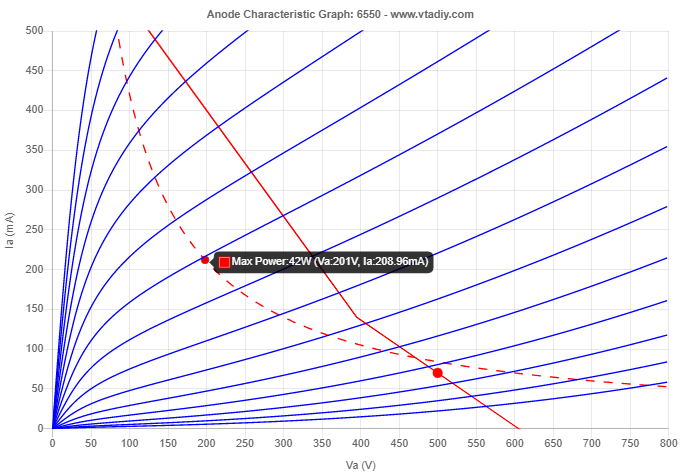
Is there any known criticity with 6550 or KT88?
I'd like to use them because I have them on hand.
Is there any known criticity with 6550 or KT88?
I'd like to use them because I have them on hand.
Attachments
Wishful thinking.I also thought that instrument amps play in a non-continuous mode (each instrument individually plays alot of pauses between notes) whilst an hi-fi amp plays continuously (all instruments summed together have way less pauses), so there’s no time to cool down “between pauses”.
NO Hi Fi amp is EVER used continuously well beyond overdriven for hours, putting out squarewaves.
Sustain in guitar playing fills the "gaps", so no "cooling time", what you imagine may apply to, say, very clean Jazz Guitar.
And Hi Fi amps are typically used with at least 10dB headroom (hence at, say, 10% maximum average power) or they start sounding "ugly" and of course, not very Hi Fi any more.
Back yo your problem:I doubt you damage your EL34 and in any case, to be certain play them in darkened room as suggested by kodabmx, watch for redplating but even more for bright screens which are deadly.
Thank you JMFahey,
aren't blasting overdriven squarewaves less "heating" for power tubes than mid power sine waves? Being the loadline a line (well, an ellipse in reality, but average a line), and the max plate dissipation an hyperbole, plate dissipation is exceeded at mid power, not full power nor idle. Am I right?
aren't blasting overdriven squarewaves less "heating" for power tubes than mid power sine waves? Being the loadline a line (well, an ellipse in reality, but average a line), and the max plate dissipation an hyperbole, plate dissipation is exceeded at mid power, not full power nor idle. Am I right?
Talking about giving EL34s a tough life, came across one of these recently, a Dynacord Eminent II PA from the 70's. A hybrid with tube output stage, 740V anode and 410V G2, and everything enclosed in a very compact box.
Dynacord Eminent II
Dynacord Eminent II
Attachments
there are no reason to test the tube power amp with square wave at (almost) max power.
Regarding the real load, the great David Manley explain why in most of the his power amp decided to set the secondary fix at 5 ohm ( totally agree), with the possibility to configure other Z just in case.
In this case the ratio primary secondary is higher from the standard Z we normally see in the circuits.
This helps also for damping factor.
But with the changing on module vs frequencies ( and phase), mainly in the region of bass ( like bass-reflex with double peak) when the Z goes low, in this way, there is a margin where the amps still works fine.
About the max rms power probably we loss something but this is not a problem with impulsive signal as music.
In attach the dynamic test done at Audioreview lab on my monos with 4 x KT150 power amp,tetrode connection, secondary set at 5 ohm.
It is a test driven by AP SYS one with a specific program and an automatic load that changes the Z when the signal reach a specific THD ( in this case 2%, as usual)
It is possible to see the differences from RMS power ( continua) and impulsive.
The blu curves is more vertical and the power deliver is much higher from RMS this because there is a "limit" comes from Joule reserve on power supply that in this case is high.
At around 3,2 ohm ( around 300 watts) the blue curves tends to go down because we are close to the minimum acceptable Z seen by the tubes in this configuration but the capacity to delivery current is high for a large range of impedance
With a poor supply normaly the blu curve is quite similar at the red line (RMS).
The photo of monos.
All these consideration are done with a test lab and not with the simulation because there is the OT and it is not possible to simulate with accuracy in the region of low and high end frequencies where the implication of iron and parasitic are specific for each type and brand of OT
Walter
Regarding the real load, the great David Manley explain why in most of the his power amp decided to set the secondary fix at 5 ohm ( totally agree), with the possibility to configure other Z just in case.
In this case the ratio primary secondary is higher from the standard Z we normally see in the circuits.
This helps also for damping factor.
But with the changing on module vs frequencies ( and phase), mainly in the region of bass ( like bass-reflex with double peak) when the Z goes low, in this way, there is a margin where the amps still works fine.
About the max rms power probably we loss something but this is not a problem with impulsive signal as music.
In attach the dynamic test done at Audioreview lab on my monos with 4 x KT150 power amp,tetrode connection, secondary set at 5 ohm.
It is a test driven by AP SYS one with a specific program and an automatic load that changes the Z when the signal reach a specific THD ( in this case 2%, as usual)
It is possible to see the differences from RMS power ( continua) and impulsive.
The blu curves is more vertical and the power deliver is much higher from RMS this because there is a "limit" comes from Joule reserve on power supply that in this case is high.
At around 3,2 ohm ( around 300 watts) the blue curves tends to go down because we are close to the minimum acceptable Z seen by the tubes in this configuration but the capacity to delivery current is high for a large range of impedance
With a poor supply normaly the blu curve is quite similar at the red line (RMS).
The photo of monos.
All these consideration are done with a test lab and not with the simulation because there is the OT and it is not possible to simulate with accuracy in the region of low and high end frequencies where the implication of iron and parasitic are specific for each type and brand of OT
Walter
Attachments
In partThank you JMFahey,
aren't blasting overdriven squarewaves less "heating" for power tubes than mid power sine waves? Being the loadline a line (well, an ellipse in reality, but average a line), and the max plate dissipation an hyperbole, plate dissipation is exceeded at mid power, not full power nor idle. Am I right?
That applies to transistors which can source any current the load wants and with very low voltage drop, so that part of the equation almost zeroes, bringing dissipation to very low levels, transistors are *almost* perfect switches.
And Mosfets even better
But Tubes are very poor switches
Personal results, coming from own measurements and design, not blindly following "standards": typical Fender design since the 50´s, they use 2 x 6L6 with some 430V plate, screens same voltage but with current limiting resistors, barely get 50 *real* watts out of them, and amps are FUSSY, requiring NOS tubes or carefully selected and matched ones.
I drew my own load lines, using many brands, and found that with same voltages but 5500 ohm plate loads I could reliably get clean 40W RMS with *any* tube, and they worked reliably for many years, in some case 15 or 20 years (verified because old Customers keep coming for more or bring others).
Getting reliable 80% of the power, beats cooking them to death in 1 or 2 (I mean heavy performing and Touring bands), in exchange of a dB or so extra power.
To boot, nowadays trend s attenuating amps down!, so .......
- Home
- Amplifiers
- Tubes / Valves
- Lowest safe loadline: what is the limit?
